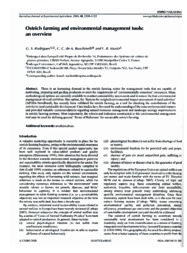Ostrich farming and environmental management tools: an overview.
Ostrich farming and environmental management tools: an overview.
Summary: There is an increasing demand in the ostrich farming sector for management tools that are capable of motivating, preparing and guiding producers to meet the requirements of ?environmentally conscious? consumers. Many methodological options are currently available to conduct sustainability assessments and to ensure the best environmental management of rural activities. One option, the ?System for weighed environmental impact assessment of rural activities? (APOIA-NovoRural), has recently been validated for ostrich farming, as a tool for checking the contributions of the activity to local sustainable development. Case studies have favoured the understanding of the main environmental impacts and provided valuable recommendations regarding natural resources management and landscape ecology improvements in ostrich farming systems. Most importantly, the criteria and indicators constructed in this environmental management tool may be used for defining general ?Terms of Reference? for sustainable ostrich farming.
Publication year: 2008
Types of publication: Journal article
Unit: Embrapa Environment
Observation
Some of Embrapa's publications are published as ePub files. To read them, use or download one of the following free software options to your computer or mobile device. Android: Google Play Books; IOS: iBooks; Windows and Linux: Calibre.
Access other publications
Access the Agricultural Research Database (BDPA) to consult Embrapa's full library collection and records.
Visit Embrapa Bookstore to purchase books and other publications sold by Embrapa.

